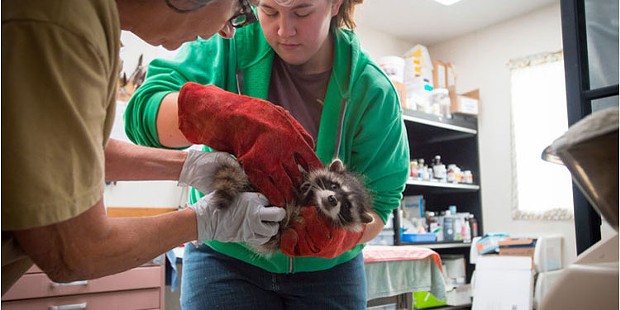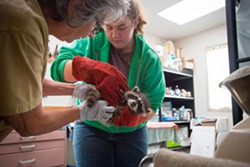Oh, Mercy
How the Humboldt Wildlife Care Center keeps wild animals wild
By Linda Stansberry [email protected] @lcstansberry[
{
"name": "Top Stories Video Pair",
"insertPoint": "7",
"component": "17087298",
"parentWrapperClass": "fdn-ads-inline-content-block",
"requiredCountToDisplay": "1"
}
]
The patient lets out a low, chittering growl, a warning. Lucinda Adamson reaches down and lifts him up onto the scale, her thick leather gloves protecting her from the juvenile raccoon's sharp teeth and claws. She examines the space between the critter's back legs to confirm his sex, then sets him back into the carrier as Jeanne Gunn, another volunteer at the Humboldt Wildlife Care Center, notes each animal's weight. The kits are about 4 months old, close to the time they'll be released into the woods. Until then, the mission of the center staff is threefold: Keep them alive, keep them healthy and — perhaps most challenging of all — keep them wild.
The Humboldt Wildlife Care Center, established in 1979, operates under the umbrella of another rescue agency, Bird Ally X. The two organizations merged in 2014. According to the nonprofit's website, the center treats more than 1,000 patients a year on a shoestring budget and a quarter-acre of land. Two welded-together double-wide trailers serve as the office, clinic and convalescent hospital. The center is surrounded by wooden outbuildings that house the animals preparing for reentry into the wild. This is not a petting zoo: The buildings are closed to observation, only entered by volunteers for cleaning, with food mostly served through small doors. On the wall of the building's main room is a patient list on a large dry-erase board, with the location where each creature was found, the conditions under which it was found (abandoned, orphaned, injured), its vital statistics, its care and feeding schedule. Asked if we can observe the baby skunks, the orphaned coyote, the pen of small, freckled fawns, Monte Merrick, co-director of the center, responds with a calm smile and an unequivocal, "No."
"They need a healthy fear of humans," says Merrick. The raccoons will soon go into boxed enclosures. When the staff need to clean, they will rap on the top of the box to flush them out of hiding. This process will be repeated when the boxes are set out in the wild, sending the kits scattering into the bushes, hopefully to find a home on their own. They will not be followed, tagged or monitored. They will not stop and deliver a last, longing look toward their human saviors in the manner of a melodramatic children's movie. Merrick and all the others who fed the kits from the time they were tiny, palm-sized infants drinking from eye droppers up until the time they began independently wolfing down pungent dishes of fish and berries, will never know what became of their wards. This isn't to say they don't care.
"This time, when we're weighing them, it might be the last time I'll be able to look at their faces and know them as individuals," says Merrick. "But this is how we love them. It's the same affection you feel for anything you love."
Merrick and his staff follow a code of ethics set forth by the National Wildlife Rehabilitators Association, which includes the coda that "all releasable animals should be maintained in a wild condition and released as soon as appropriate." This is key to rehabilitators "respecting the wildness and maintaining the dignity of each animal in life and in death."
So there is no cooing over their charges, not much talking at all, so the small beasts won't become accustomed to human voices. There is no cuddling, no petting, no baby opossums scurrying adorably underfoot. There is medical care and food, and endless enclosures to clean. As Merrick explains how real rehabilitation is nothing like The Yearling, volunteers walk briskly up and down the hallway with syringes and charts like charge nurses on a tight schedule. It's late spring, baby season, and with five fawns, 23 raccoons, 12 opossums, nine skunks, dozens of birds, one fox, one coyote and a baby brown bat to care for, there's little time for sentimentality.
But still ... When Shar Parada, a zoology student at Humboldt State University, leads us into the room where the baby raven is awaiting its food, his box is covered with a soft baby blanket. And when the raven, which is bony and wrinkled and covered sparsely by prickly pinfeathers, a creature that looks like a cross between a dinosaur and a rotting banana, opens its wide pink maw and utters a squeaky, burbling croak, everyone lets out an involuntary murmur of adoration. The raven, leaning back its head and gobbling down the food Parada puts in his throat with a pair of forceps, stops eating long enough to scoot its naked backside over the edge of his felt-lined nest and take a large, runny dump. Parada beams.
"Isn't that cool, how he knows how to lavage outside of his nest?" she says, no small hint of parental affection in her voice.
A great deal of the center's patient load is comprised of birds — an owl injured in a roadway, barn swallows whose nests were hosed off the eaves of a house, songbirds dragged in by someone's cat. As with the rest of the animals, they require constant care. In the aviary, a small building with a netted doorway to prevent escapes, a nest of swallow hatchlings is ensconced in a small side enclosure. Intern Marina McWhirter sticks food down their gullets as they sound a refrain of need. These babies came into town on a truckload of hay. In the main area, an orphaned finch and a swallow with head injuries flit from branch to branch. McWhirter smiles as the finch divebombs her and scolds, swooping to take food from forceps in between reminding her that she's unwelcome.
"It's good to see them want to feed on their own," says McWhirter. This is her fourth day working at the center. Like Parada, she is a zoology student, minoring in psychology.
Merrick says the finch's behavior is an indication he may soon be ready to fly away.
"One of the fantastic aspects of birds is ... one day, a switch goes off and they don't need you anymore," he says. Also at the center, housed in the octagonal area Merrick calls the "octaviary," are a Steller's jay that came in as a nestling and a crow from Fort Dick with a neurological disorder.
Merrick refers to himself as "one of the rare people doing this work that actually likes to talk to other humans." Eloquent, quick-witted, passionate, with a wild mop of curly hair and laugh lines etched at the corners of his expressive face, he began work as a wildlife rehabilitator later in life. He was 36, living in Seattle and stripping furniture for a living when the tanker New Carissa ran aground on the Oregon coast, spilling 70,000 gallons of fuel.
Merrick, watching coverage of the spill on television, was captivated by a rugged-looking man interviewed about his efforts to rescue sea birds, around 3,000 of which were killed in the spill. The station described him as a wildlife rehabilitator. Merrick turned to his then-partner.
"You can be a wildlife rehabilitator?" he asked. A series of chance meetings and volunteer work brought him to his current position. The founder of Bird Ally X, Merrick is most interested in oil spill rehabilitation, although there are few opportunities to do that kind of work. None of his various careers has been his life's work, he says. Merrick is first and foremost a poet. In the course of our interview, he quotes Ralph Waldo Emerson and Joan Didion, and debates the connotation of the word "imprint." Animals don't "imprint" on us from birth the way it's been described, he insists. They may habituate, but who knows?
"We don't even know the inner psychology of our own spouses," he says. How, then, would we presume to know what's going through the mind of a baby opossum or an injured fox?
The work is humble and seems to suit him. It doesn't match the image of the man he saw striding across the oil-streaked beach in 1999, but it's rewarding in its own way.
"That guy, he looked heroic. I'm not heroic," he says. "There's no glory in this. Well, maybe some personal glory. Not many people know what a mallard's tongue feels like."
He gets a far-off look in his eyes as he says this.
Almost all of the animals that end up at the clinic come as the result of human cruelty or human carelessness, Merrick says. Roughly half are euthanized upon arrival due to irreparable injuries. Others beat the odds, sometimes miraculously. Last week, a turkey vulture traveled from Willits to Eureka in the grill of a motorist's car after being struck on U.S. Highway 101. The drivers of the car were posing for pictures with the injured and stunned creature in the Co-op parking lot when a good Samaritan stopped and discovered the bird was still alive. It was extremely lucky, Merrick says, and began responding to treatment immediately. Other creatures, the gull with its wing torn off, the opossum with the fractured skull, find mercy on the operating table that they might not find if left on the side of the road or in a backyard.
More often than not, the humans who turn over animals to Merrick's care have good intentions, like the mother who brought in a nest of barn swallows after her son insisted. His mother thought that caring for them would be a good learning opportunity for her kid, she said, but they were failing. The boy was in tears when they surrendered them, saying that he had told his mother they needed more professional care.
Merrick is no stranger to the impulse. As a child growing up in New Jersey, he once tried to keep a drawer full of squirrels alive by feeding them cow's milk. They died one by one, leaving an indelible impression on him.
"People are, by and large, good," says Merrick, saying that he generally holds his tongue when people bring in baby animals that were most likely not abandoned, just left for a spell while their moms went off to forage. "We really hate to smack compassion."
Still, each one of those babies has been permanently separated from its parents, the entities that offer the best chances of survival. Fawns are particularly vulnerable to this disruption. In the spring, they're often left to hide in the tall grass as the does graze, and humans take them home assuming they've been abandoned. In the first 30 days of their lives they're susceptible to habituation. The staff feed them using a bottle rack inserted through a small, rectangular door on the side of the pen. Only the tips of their tiny noses are visible, so they cannot see humans and associate their presence with food. They'll be returned to where the rehabilitationists know there are existing deer herds, in Big Lagoon or Southern Humboldt, but whether they'll actually find their place in a herd of strangers is impossible to know.
Much of what the team does is interventionist in nature. A community member calls, saying there's a nest of skunks under his or her house, or a raccoon eating the dog's food. This is Merrick's chance to prevent a family from being broken up.
"The only time you're going to see animals wandering around are if they have babies," he says. "We try to peacefully resolve human wildlife conflicts."
People often think that using a humane trap to catch and release an animal in the wild is, well, humane. But Merrick says it's anything but.
"I mean, I'd love to be picked up and set in Berlin, but that's not good for the animals," he says. A raccoon or opossum moved to unfamiliar territory will probably die and, more often than not, leave a nest of babies behind to starve. The kindest thing to do, he says, is to wait it out until the babies are mobile and the family will probably relocate on its own.
Along with day-to-day prevention, intervention and rescue, the center also tries to offer educational and outreach opportunities. Merrick says he would like the center to eventually become a destination for people interested in rehabilitation. But between the constant work and the small budget (surviving off $120,000 a year works out to roughly $100 to spend on each animal), there isn't enough time to build it up to the level he'd like to see. He still manages to keep a blog going on the website. It's full of short, enthusiastic vignettes about paralyzed foxes, recuperating bats and dramatic mallard rescues. As one would expect from a poet, the posts are both pithy and narratively riveting. A recent piece about orphaned baby skunks includes a suggested musical track to accompany the reading, Cornell Dupree playing Joe Zawinul's "Mercy, Mercy, Mercy."
Also included in HWCC's scope and mission is advocacy, although this has proven challenging in the past.
"I mean, if it's Aleutian geese or beef ranchers, the beef ranchers are going to win," says Merrick. "We do spend time educating people who don't like us. We're like the Red Cross. We don't pick sides."
Some animals, mostly non-natives like the Eurasian red fox, are ineligible for rehabilitation under California statutes. Opossums, once considered to be imported from Mexico, have seen a status revision in recent years. Due to their large litter sizes and the tendency of the marsupials to dart across rural roads, the center sees a lot of opossums.
"Every time a mom gets hit, our caseload jumps by 12," says Merrick.
While they get a bad rap, opossums are rather fascinating critters. They're attentive mothers and they eat ticks. Every year, the center admits around 50 babies, pulled from the pouches of their dead mothers. Many of the fawns, too, were found next to the corpses of their mothers on the side of the road.
"They're traumatized," says Merrick. And you can hear in his tone, again, that worry and affection. The animals the team cares for, they don't get cute names or collars or strokes on the head. But they get this particular brand of love, the kind that will allow them to walk away from their saviors without a backward glance.
Linda Stansberry is a staff writer at the Journal. Reach her at 442-1400, extension 317, or [email protected]. Follow her on Twitter @LCStansberry.
Speaking of...
-
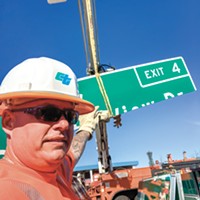
Dinsmore Remains in Limbo Amid Jurisdictional Questions
Oct 20, 2023 -
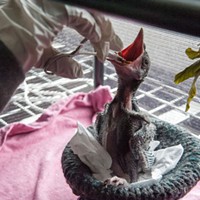
Humboldt Wildlife Center Puts Out 'Code Red' Call for Help
Sep 7, 2023 -
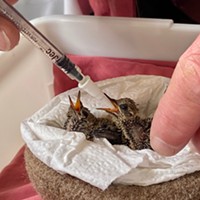
A Bird in Hand
Aug 17, 2023 - More »
more from the author
-
Lobster Girl Finds the Beat
- Nov 9, 2023
-
Tales from the CryptTok
- Oct 26, 2023
- More »
Latest in News
Readers also liked…
-
Through Mark Larson's Lens
A local photographer's favorite images of 2022 in Humboldt
- Jan 5, 2023
-
'To Celebrate Our Sovereignty'
Yurok Tribe to host gathering honoring 'ultimate river warrior' on the anniversary of the U.S. Supreme Court ruling that changed everything
- Jun 8, 2023
